Brass Fetcher Ballistic Testing
When you care enough, you send the very best. For all practical purposes this is the 12 gauge shotgun. Where the ‘rub’ comes in is dealing with the recoil. The recoil produced from 12 gauge shotguns firing buckshot is moderate-to-heavy depending on the experience and physical fitness level of the shooter. Most practical shooting events, such as using a television for cover and shooting across your living room at an intruder, involve odd shooting/body angles and require quick follow-up shots in the case of a miss or ineffective shot. The heavy recoil of the 12 gauge shotgun works against you in terms of delivering quick follow-up shots. If your security concerns extend to longer-range shots or carrying the gun in the woods it would be a good idea to practice shooting from the prone and kneeling positions. These positions steady your aim and lower your chances of being hit by return fire—but they increase the amount of felt recoil when you pull the trigger.
Most people are not ‘born fighters’ despite ego and vanity that speak to the contrary. It’s almost a given that criminals are a combination of coward and businessman—they are only attacking you because they think they can get something and then get away when they are done. Acts of heroism are rare amongst the population of law-abiding citizens. This is why they are so memorable. A criminal will likely not stand around and fight once you demonstrate that you will. The physics of handling those criminals who do stick around … will be addressed now.
Below you see a time-lapse progression of a 00 buckshot shell being fired at a composite of ballistic simulant materials simulating the human pelvis (200 lbf male standing in a Weaver shooting stance). While the ability of the buckshot spheres to penetrate such a thin target was never in question, the interest was in determining the magnitude of damage done to the bone simulant plate and from there to develop a qualitative measurement of the incapacitative capability of a shot with such a gun to the pelvic region. An attacker who cannot stand cannot run and an attacker who cannot run is much less of a threat to you than one who can.
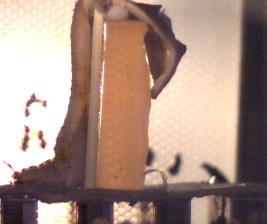
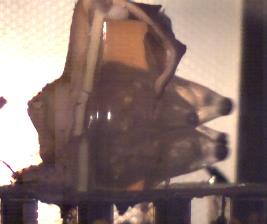
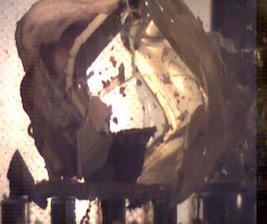
One-shot stops happen mostly in the movies so we consider the damage done by individual shot pellets in the event that not all pellets connect with the target:
 Figure 1: Kinetic Energy Transfer—Penetration Depth
Figure 1: Kinetic Energy Transfer—Penetration DepthEach shot pellet from a 00 buckshot shell (muzzle velocity 1225 ft/sec) has greater lethality than a 380 ACP 90gr JHP shot at 900 ft/sec. If all pellets connect, the effect on the target will be similar to a 15-shot burst from a 380 ACP submachinegun. The 12 gauge shotgun is the king of close-range shooting.
Notice from Figure 1 that the maximum penetration depth was 14.8 inches in 20% ballistic gelatin. This penetration depth in that medium is far too deep - valuable wounding potential would be lost out the back of the target as the pellets would still have substantial velocity on the exit side. Smaller buckshot spheres can be used to remedy this situation. In addition to losing more kinetic energy in the target, they also create more holes and increase hit probability.
Much can be said in general terms about shotgun capability since the common shotguns gauges all propel the buckshot at approximately the same velocity.
Shotguns are designed for close-range usage. It is therefore reasonable to see the value of shotguns in close-range environments as is encountered in and around automobiles and inside of houses. Shotguns are limited in the ability to penetrate intermediate barriers such as car windshield glass and car doors when using buckshot. Conventional buckshot is made of lead, which is a soft material that wastes considerable energy deforming during an impact with a harder material such as mild steel or glass.
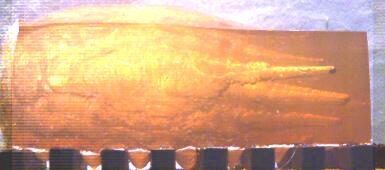 000 Buckshot Bare gelatin Penetration - 15.6”
000 Buckshot Bare gelatin Penetration - 15.6”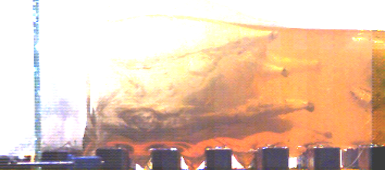 000 Buckshot Car Windshield + Bare gelatin Penetration - 9.3”
000 Buckshot Car Windshield + Bare gelatin Penetration - 9.3” 000 Buckshot Car Door + Bare gelatin Penetration - 10.1”
000 Buckshot Car Door + Bare gelatin Penetration - 10.1”The smallest shot size that I recommend for an environment that involves cars is 00 buckshot. Pictured above is 000 buckshot. If the range is increased much beyond 25 yards the terminal effectiveness of conventional buckshot against harder targets is questionable.
It is my desire to see the commercial shotshell manufacturers develop a shotshell loaded with tungsten carbide shot. Tungsten is a favorite metal for the designers of high performance armor piercing ammunition because of its high density and hardness. Whatever it hits will ‘break’ long before the tungsten ‘breaks’. Using tungsten would increase soft target terminal effectiveness by allowing deep-penetrating, smaller shot sizes to be used and would also allow the effective engagement of targets using soft cover as protection. The weight of each shell and the cost would be great but eventually economy of scale would make such a shell more accessible to shooters.
Seen from Table 1, such a shell would add 0.64 ounces per shell to the load carried by a shotgunner. A 6-shot shotgun would increase in weight then by 3.84 ounces and a 8-shot shotgun would increase in weight by 5.12 ounces. With a pouch holding two reloads, a person armed with a Mossberg 590 would increase their weight burden by roughly one pound when using the optimum buckshot configuration.
Without knowing what the future may bring, we can look with certainty upon the past and formulate trends for the future. Mankinds recent past has sadly been highlighted by indiscriminate inter-species killing and global warfare. The adoption of the Keynesian economic model by most governments has wrought havoc with global economies since the 1930s and promises to unleash as-yet unknown suffering on us in the future. With uncertainty comes unrest and unrest always leads to violence.
The traditional viewpoint of “just pump the shotgun—the noise will scare them out of your house” increasingly does not fit with reality. What if you have something an intruder(s) wants or believes they need to survive? It will then be a question of “them vs you.” You must win that conflict because there is no other way out of such a situation. Maybe the first shot will stop them … or maybe all shots fired will miss and now we must reload under stress.
There is a similar technique to use to transition to slugs. If you find me out at the test range you will find my Mossberg 590 laying around somewhere as well. The load is all #1 buckshot but I will have two rifled slugs in my speed loader which is attached to my belt.
If something were to pop up at greater than 50 yards, the gun can be cleared by pressing the bolt carrier release lever and pumping the weapon fully rearward while rotating the ejection port to face the ground. Use the same ‘slam dunk’ procedure to reload your weapon with the slugs.
The ammo that was dumped on the ground validates the good advice of carrying spare ammunition outside of the weapon itself…
More Info
12 Gauge Shotgun Terminal Ballistics
Bare Gelatin Shots from 15 Different Ammo Types
